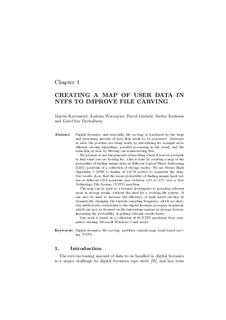| dc.contributor.author | Karresand, Nils Martin Mikael | |
| dc.contributor.author | Warnqvist, Asalena | |
| dc.contributor.author | Lindahl, David | |
| dc.contributor.author | Axelsson, Stefan | |
| dc.contributor.author | Dyrkolbotn, Geir Olav | |
| dc.date.accessioned | 2019-12-04T12:44:00Z | |
| dc.date.available | 2019-12-04T12:44:00Z | |
| dc.date.created | 2019-09-30T12:53:05Z | |
| dc.date.issued | 2019 | |
| dc.identifier.citation | IFIP Advances in Information and Communication Technology. 2019, 569 133-158. | nb_NO |
| dc.identifier.issn | 1868-4238 | |
| dc.identifier.uri | http://hdl.handle.net/11250/2631764 | |
| dc.description.abstract | Digital forensics and, especially, file carving are burdened by the large amounts of data that need to be processed. Attempts to solve this problem include efficient carving algorithms, parallel processing in the cloud and data reduction by filtering uninteresting files. This research addresses the problem by searching for data where it is more likely to be found. This is accomplished by creating a probability map for finding unique data at various logical block addressing positions in storage media. SHA-1 hashes of 512 B sectors are used to represent the data. The results, which are based on a collection of 30 NTFS partitions from computers running Microsoft Windows 7 and later versions, reveal that the mean probability of finding unique hash values at different logical block addressing positions vary between 12% to 41% in an NTFS partition. The probability map can be used by a forensic analyst to prioritize relevant areas in storage media without the need for a working filesystem. It can also be used to increase the efficiency of hash-based carving by dynamically changing the random sampling frequency. The approach contributes to digital forensic processes by enabling them to focus on interesting regions in storage media, increasing the probability of obtaining relevant results faster. | nb_NO |
| dc.language.iso | eng | nb_NO |
| dc.publisher | Springer Verlag | nb_NO |
| dc.title | Creating a map of user data in NTFS to improve file carving | nb_NO |
| dc.type | Journal article | nb_NO |
| dc.type | Peer reviewed | nb_NO |
| dc.description.version | acceptedVersion | nb_NO |
| dc.source.pagenumber | 133-158 | nb_NO |
| dc.source.volume | 569 | nb_NO |
| dc.source.journal | IFIP Advances in Information and Communication Technology | nb_NO |
| dc.identifier.doi | 10.1007/978-3-030-28752-8_8 | |
| dc.identifier.cristin | 1731383 | |
| dc.relation.project | Norges forskningsråd: ArsForensica 248094 | nb_NO |
| dc.description.localcode | This is a post-peer-review, pre-copyedit version of an article published in [IFIP Advances in Information and Communication Technology] Locked until 7.8.2020 due to copyright restrictions. The final authenticated version is available online at: https://doi.org/10.1007/978-3-030-28752-8_8 | nb_NO |
| cristin.unitcode | 194,63,30,0 | |
| cristin.unitname | Institutt for informasjonssikkerhet og kommunikasjonsteknologi | |
| cristin.ispublished | true | |
| cristin.fulltext | postprint | |
| cristin.qualitycode | 1 | |
